Question and Answer – January 2009
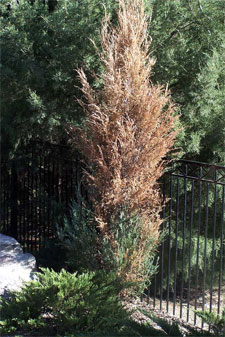
Question: The picture shows a Skyrocket juniper, planted in my back yard, which appears to be dying. I have four others in the back yard that are all still healthy. All were planted four years ago. Any ideas on what is causing this? Is it safe to plant another one in the same area? M.O., Fairview
Answer: I’ll give it my best, but it’s still going to be a guess. On first view, it looks like it almost has to be drought damage. It actually looks like a new plant that was allowed to get way too dry at one or more times before its roots could grow out into the adjacent soils and more normal irrigation. This happens frequently with new plantings. However, four years is long enough that that makes me question that particular answer. Then I think of spider mites. They can be really devastating, but their damage starts at the ground and works its way up the plant. There is little or no damage at the base of this plant, so there goes Possibility Number 2. The third would be some type of catastrophic damage to the main trunk, perhaps from being snapped, a bagworm bag tied around and girdling it, some other type of mechanical injury, etc. Please look at the stem at the point of dieback and see if anything pops out at you. Finally, there is a bacterial stem canker that kills twigs and branches of many varieties of junipers rather suddenly. The dead tissue must be pruned out, and the plant must be protected with a copper-based fungicide from a nursery. Spray monthly during the growing season. It’s way too late, of course, to worry about this plant. If you want to replant in this area, you can certainly do so, although I have to confess that I would probably choose another species or at least a different juniper in the event that a disease might have been involved.
So, those are my answers. They’re all valid. I just am not sure any of them applies to this specific situation. I hand it back to you with a pat on the back and a smile. Good luck!
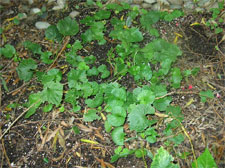
Question: I have always used violets as borders and groundcover in parts of my shady back yard. This past year the leaves appear to have been chewed around the edges. In some spots they dwindled down to a few. What could the problem be? The only thing I can think of is that I feed the birds in another area of the yard, and periodically we have had trouble with mice and rats. Do they do this kind of damage? K.F., Lewisville
Answer: This is not mouse and rat damage. They don’t chew semi-circles. In fact, the pest that does the best job of that is the leaf-cutter bee. The adult female cuts these perfect partial circles from the edges of the leaves, then she takes them back to her nest-building site (often a seldom-used faucet). Some day in the future, you’ll come across the nest as you turn the water on and the nest blows out on your shoes. You’ll recognize the dried remains of your violet foliage. I haven’t seen them bother violets like this, but they tear into roses. There is no chemical control for them. They "hit-and-run," cutting the leaves without ingesting them. They’re gone within seconds. The good news is that they’re worse some years than others. Odds are that you’ll not see their damage again for many years.
One other thing worth watching: in the off chance that this might be pillbugs, keep your eyes open come spring. If you see large numbers of them, and if the damage seems to be getting worse at night (leaf-cutter bees fly in daylight), dust the bed with Sevin.
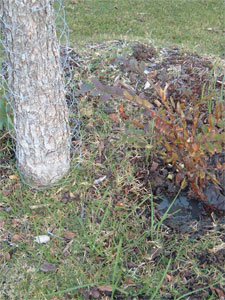
Question: Last June a landscape company planted this cedar elm in our back yard. The tree has a 4.5-inch diameter trunk. A few weeks later, two small cedar elms sprouted on each side, about one foot from the trunk. After digging down a few inches, we discovered that the new trees are sprouting from 3-inch diameter trunks that had been sawed off below the soil. Are these part of the root system of the main tree? How can we eliminate the young trees? Are some cedar elms multi-trunked? S.H., Mesquite
Answer: Some cedar elms are multi-trunked, but that’s almost always the case because there are two or more separate and distinct trees growing within a naturally occuring clump. It would be very difficult to get back to that point starting with one large tree and two sets of sprouts. Our vote here is simply to keep them trimmed back until they give up and die.
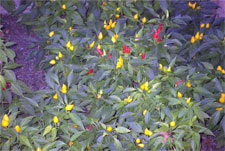
Question: I received seeds from a friend in March and planted them. These pictures show what grew. We love them and would like to know what they are and how to get the seeds to plant again. T.I., Plano
Answer: Those are ornamental peppers. I can see several different fruit forms, so it must have been a mix. Hopefully, you saved seeds from these. If so, they can be planted next spring. If you want to try other types, there are scores and scores in the seed marketplace. Shop online, or visit garden centers in spring and summer for started transplants.

Question: We transplanted two juniper trees to our yard from a house in Dallas about eight years ago. They were probably 10 or more years old. The one in the back yard is like a twig now because of all of the dead branches we’ve had to cut out. We suspect it was spider mite damage, but we also wonder if it had a disease. The inside of the trunks was reddish. We’re now seeing the same thing on the second juniper, on the side of our house. It has looked great, but branches started dying one by one within the last few months. I pruned out the dead branches and noticed that the inside of its trunks was also red. As a side note, as I was pruning lower on the trunk, I did see web-like threads. Dead needles were hanging from them. If it’s spider mites, did they come first, or attack because the tree was already weak from a disease? Neighbors have had similar problems. S.W., Richardson
Answer: I actually looked at your photo before I read your question, and there is no doubt about the spider mites. These are characteristic visual symptoms (starting on bottom of the plant and flushing upward). The fact that you saw the webbing nails it down for certain. You can actually see the nearly microscopic mites if you’ll thump affected twigs over white paper. If they don’t show up there, repeat it over a piece of glossy, dark-colored paper. The mites were the sole cause of the problem. Curiously, this mite shows up pretty much all year long, winter included. (Most mites are hot-weather pests.) You could stop further damage at any point by spraying with a general-purpose insecticide. We do not have specific miticides currently.
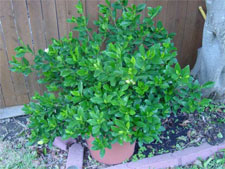
Question: My gardenia has grown beyond all expectations. I’d like to pot it into a larger container. When should I do so? Any other special tips? M., The Colony
Answer: You’ll have to baby the plant along through the winter. You lose about 20 degrees’ worth of winter hardiness when you have plants outdoors in containers. Keep it very bright, cool and moist until you plant it outdoors in early spring. If you want to repot it and leave it in a large container, that would also be the time to do that as well.
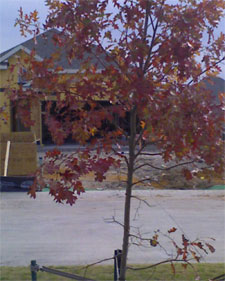
Question: This Shumard red oak is growing in really rocky soil. I think it’s gotten too dry, but my father-in-law says he waters it regularly. Any suggestions? R., Celina.
Answer: It’s really hard to distinguish what, if any, problem might be involved with your tree from this photo and without knowing when you took it. It actually looks pretty much like normal fall color. If it was brown way too early this fall, then you were probably right – it probably did get too dry at least once. Check the trunk, too, to be sure it has no sunscald or borer invasion caused by not wrapping and protecting the trunk for its first year in your garden. Otherwise, you may want to visit with a local Certified Nursery Professional if you think it still has problems.

